
Wine Culture and Information since 2002 - Volume 22
 Wine Culture and Information since 2002 - Volume 22 |
|
Contrasts of Gutturnio Classico Superiore and Sicilia MerlotOne of the most famous wine made in Piacenza compared to a monovarietal wine from Sicily, produced with the most famous and celebrated international red berried grape |
|
Emilia-Romagna and Sicily. Two regions that are very different in every aspect, especially from the climatic, viticultural and wine making points of view. Even the respective traditions and enological histories are distant and different, the vineyards are colored with grapes and varieties typical and identifying in the respective regions, the wines are historically and traditionally produced in different styles. In Emilia-Romagna, in fact, the enological history – which is common to all areas of the very large Po Valley – is characterized by a wealth of stingy and alive wines, therefore sparkling, a tradition that is still common today in the whole region. In Emilia-Romagna, of course, are produced not only sparkling wines and today these joyful wines – the family of magnificent Lambrusco grapes above all – are richly supported by the production of dry and still wines of equal fame and quality. Sicily, of course, is no less in terms of enological tradition and history. The climate and the enological culture of the largest Italian island has however led to the birth of wines very different from those of Emilia-Romagna: here the story mainly speaks about wines from dried grapes and oxidative wines, Marsala above all. In Sicily, of course, there has never been a lack of dry table wines, a production characteristic that is still fundamental and significant for the region today. In this regard, it should be noted that a very important experimental movement took place in Sicily with the aim of studying and identifying the viticultural and enological potential of many varieties in its territory, including the so-called international grapes. In Sicily, in fact, the cultivation of international varieties is nowadays as common as the cultivation of the many native grapes, often blended to local varieties in the production of wines as well as used alone.
|
|
Although viticulture and wine production in the Piacenza area has ancient origins, the history of Gutturnio wine – the most famous and celebrated one of these lands – has a relatively recent history. There are many historical proofs telling about of the presence of the vine in the territory of Piacenza and dating back to the times of the ancient Romans, there are many documents and proofs about the quality of the wines of this territory and, last but not least, also appreciated in other areas of the Roman Empire. In any case, these wines were completely different from those produced today and which are identified with the name Gutturnio, both for production methods and for the grapes used. Gutturnio takes its name from a jug in use in ancient Rome – the gutturnium – made of silver and with a volume of about two liters. This jug was used at the end of a banquet and passed among the diners, who drank in turn from the same gutturnium as a sign of friendship and fraternity. This jug has become inextricably linked with the Piacenza wine after the discovery of a gutturnium during the excavations of the ancient Roman village Veleia around the end of the 1800s. It was around the end of the 1930s that it was decided to call the wine of Piacenza with the name of the Roman libation jug. The history of the grapes used for the production of Gutturnio is also relatively recent. The famous wine of Piacenza is produced with Barbera – 55 to 70% – and the remaining part of Croatina, the latter locally called Bonarda, according to the custom of the western Po Valley, and has no connection with the true and homonymous Piedmontese variety. The cultivation of these two grapes in the Piacenza area is quite recent and they have assumed primary importance only after the reconstruction of the vineyards following the devastation caused by phylloxera. Specifically, Barbera was introduced in these lands in the mid-1800s, while Croatina at the beginning of the 1900s, becoming common and spread starting from the 1930s. According to the production disciplinary, Gutturnio is produced in the frizzante (sparkling), superiore, classico superiore, riserva and classico riserva styles. For our tasting, we will examine Gutturnio Classico Superiore.
|
||||
|
Sicily has a remarkable ampelographic richness, made of both native and international varieties, the latter introduced on the island following the experimentation that took place in Sicily with the aim of identifying the most promising and profitable grapes in enological terms. The result of this activity has been the vast spreading of many international varieties throughout the territory of Sicily, also introducing in the island varieties, so to speak, that could be seen as unsuitable for this territory – such as Pinot Noir, Müller Thurgau and Sauvignon Blanc – and which here gave origin to interesting wine making interpretations. This also included, of course, Merlot and which today is among the main international red berried varieties mainly cultivated in Sicily, together with Cabernet Sauvignon and Syrah. The expression of these varieties in Sicily is – all too obvious – strongly affected by the typical climate of the island, producing interpretations that are, not only very distant from their lands of origin, but also from the rest of Italy. The spreading of international varieties in Sicily has been huge and involved the entire wine production of the island, in some respects, even to completely change it when compared to the past, not only blended to the typical indigenous varieties but also permitted in many DOC production disciplinary of Sicily. The success of international varieties in Sicily is however undeniable and the wines produced here with these grapes prove the good adaptation to this land even with an interesting personality. The climate of course plays a fundamental role, in particular the high temperatures that cause the accentuation of certain “round” characteristics of the wines, a quality which is evident, in particular, in those produced with Merlot and Chardonnay. The famous Bordeaux red grape, among the many international varieties cultivated in Sicily, is the variety we will examine in this tasting, putting it in contrast with Gutturnio.
|
Before pouring the wines of this month's tasting by contrast, let's proceed with the choice of the bottles we will examine. For both wines, the respective production disciplinary – both Gutturnio Classico Superiore and Sicilia Merlot are recognized as Denomazione d'Origine Controllata (Denomination of Controlled Origin, DOC) – provides for the possible aging in wooden containers. Our choice will be oriented towards wines produced exclusively using inert containers, in particular the stainless steel tank. As for the composition, we will choose a Gutturnio Classico Superiore produced with the maximum allowed quantity of Barbera, therefore 70%, and the remaining Croatina, as these are the only two grapes legally allowed for the production of the wine of Piacenza. As for Sicilia Merlot, we will make sure it is produced exclusively with this grape, while noting that – as this is something usually happening – the disciplinary provides, for mono varietal wines, the minimum use of 85% of the grapes declared in label. Both wines belong to the most recent vintages and served in tasting glasses at a temperature of 18 °C. (65 °F) Let's pour Gutturnio Classico Superiore and Sicilia Merlot into their respective tasting glasses and begin the evaluation of the appearance of the two wines, starting with the one from Piacenza. We tilt the glass over a white surface – a sheet of paper is enough – and observe the base, where the thickness of the wine is greater. We can observe a brilliant and intense ruby red color and, by placing a contrasting object between the glass and the white surface, we can detect a moderate transparency. Let's now observe the nuances of Gutturnio Classico Superiore, let's then focus our attention towards the opening of the glass, where the thickness of the wine is thinner. In the wine of Piacenza we can see an intense ruby red nuance, therefore confirming the base color. Let's move on to the observation of Sicilia Merlot and, by tilting the glass over the white surface, let's evaluate the color at the base. The color of the Sicilian wine is intense ruby red and, in general, darker than Gutturnio Classico Superiore. Transparency, after having placed a contrasting object under the glass, is moderate and generally lower than the wine of Piacenza. The nuance of the Sicilia Merlot, observed towards the opening of the glass, confirms the ruby red color. Barbera, Coratina and Merlot. Three different grapes in every respect, from the viticultural one to the respective sensorial qualities. Moreover, if we add to this the influence of the territory and, no less important, the interpretation of those who make wine, the distance is further accentuated. Barbera and Croatina – this last known in the western Po Valley as Bonarda and not to be confused with the real Piedmontese Bonarda – makes wines which are often characterized by aromas reminiscent of red pulp fruits, in particular cherry, raspberry, strawberry, often combined with blueberry, blackberry and plum. Among the most frequent floral recognitions, in Gutturnio Classico Superiore we perceive violet and rose. The olfactory profile of wines produced with Merlot – the famous red berried grape of Bordeaux – have a very different olfactory profile, which are mainly characterized by aromas of dark pulp fruits, especially black currant, black cherry and plum, a characteristic also found in Sicilia Merlot. Among the aromas reminiscent of flowers, in this wine is usually perceived violet and, frequently, peony as well. Let's resume the tasting by contrast of this month and proceed with the evaluation of the olfactory profiles of the two wines, starting, as in the previous phase, with Gutturnio Classico Superiore. Let's hold the glass in vertical position and, without swirling, let's proceed with the first smell in order to examine its opening, that is the identifying aromas of the wine. From the glass are perceived, intense and clean, aromas of cherry, raspberry, plum and strawberry to which follow the elegant scent of violet. Let's swirl the glass – an operation favoring the oxygenation of the wine, therefore the development of the other olfactory qualities – and let's proceed with the second smell. From the glass we can now perceive aromas of blackberry and blueberry, frequently followed by the scent of rose. Let's now move on to the olfactory evaluation of Sicilia Merlot and, by keeping the glass in vertical position and without swirling, let's evaluate its opening. The Sicilian wine is characterized by aromas of black currant, black cherry and plum followed by violet. After having swirled the glass, Sicilia Merlot completes its olfactory profile with blueberry, peony and, sometimes, carob. Let's now pass to the gustatory evaluation of the two wines, first examining Gutturnio Classico Superiore. The first evaluation we will carry out in this wine is about its attack, that is the primary sensations perceived in the mouth and, in some respects, capable of defining the “personality and character” of a wine. Let's take a sip of the wine of Piacenza: in the mouth we immediately perceive the moderate astringency of the tannins as well as the pleasing and typical crispness produced by the acidity of Barbera. The wine reaches its balance with both the proper effect of alcohol and Croatina, moreover, in the mouth we perceive – clean and intense – the flavors of cherry, raspberry, plum and strawberry. Let's now proceed with the evaluation of the attack of Sicilia Merlot, therefore let's take a sip of this wine. In the mouth we can immediately perceive the round character of Merlot – which is also combined with the effect of alcohol – reaching its balance with astringency, perceptible but definitely rounder than Gutturnio Classico Superiore. In the mouth we also perceive the flavors of black currant, black cherry and plum. Our tasting by contrast has reached the final evaluation of the sensations the wines leave in the mouth, in particular, the so-called taste-olfactory persistence, a primary factor in determining the quality of a wine. The first wine of which we examine the final sensations is, just like the previous phases, Gutturnio Classico Superiore. The finish of the wine of Piacenza is persistent, leaving in the mouth a pleasing sensation of crispness – of which Barbera is the main responsible – and pleasing flavors of cherry, raspberry and strawberry. The finish of Sicilia Merlot is completely different in the sensations left in the mouth. Its persistence is certainly good, and it is mainly perceived the round sensation of Merlot which tends to also round out the astringency, however perceptible. In the mouth we continue to perceive intense flavors of black currant, black cherry and plum. We conclude the tasting by doing a final olfactory and gustatory evaluation of both Gutturnio Classico Superiore and Sicilia Merlot: the two wines are very different and distant in every single sensorial quality.
|
||||||||
Wines of the Month |
|
|
|
Score legend Prices are to be considered as indicative. Prices may vary according to the country or the shop where wines are bought |
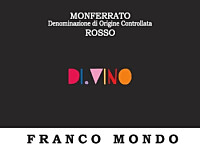
|
|
Monferrato Rosso Di.Vino 2017 |
|
| Franco Mondo (Piedmont, Italy) | |
 Barbera (70%), Cabernet Sauvignon (30%) Barbera (70%), Cabernet Sauvignon (30%) | |
| Price: € 9.00 | Score: |
 Intense ruby red and nuances of ruby red, little transparency. Intense ruby red and nuances of ruby red, little transparency. Intense, clean, pleasing and refined, starts with hints of cherry, plum
and black currant followed by aromas of violet, blueberry, chocolate,
tobacco, pink pepper, vanilla and menthol. Intense, clean, pleasing and refined, starts with hints of cherry, plum
and black currant followed by aromas of violet, blueberry, chocolate,
tobacco, pink pepper, vanilla and menthol.
 Properly tannic attack and however balanced by alcohol, good body,
intense flavors, agreeable. Properly tannic attack and however balanced by alcohol, good body,
intense flavors, agreeable.
 Persistent finish with flavors of cherry, plum and black currant. Persistent finish with flavors of cherry, plum and black currant. 6 months in barrique. 6 months in barrique. |
|
 Broiled meat and barbecue, Stewed meat with mushrooms, Hard cheese Broiled meat and barbecue, Stewed meat with mushrooms, Hard cheese |
|
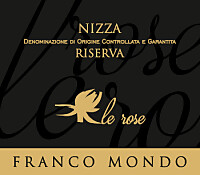
|
|
Nizza Riserva Le Rose 2015 |
|
| Franco Mondo (Piedmont, Italy) | |
 Barbera Barbera | |
| Price: € 25.00 | Score: |
 Intense ruby red and nuances of garnet red, little transparency. Intense ruby red and nuances of garnet red, little transparency. Intense, clean, pleasing, refined and elegant, starts with hints of
cherry, plum and dried violet followed by aromas of blueberry, blackberry,
cocoa, tobacco, licorice, leather, cinnamon, mace, vanilla and menthol. Intense, clean, pleasing, refined and elegant, starts with hints of
cherry, plum and dried violet followed by aromas of blueberry, blackberry,
cocoa, tobacco, licorice, leather, cinnamon, mace, vanilla and menthol.
 Properly tannic attack and however balanced by alcohol, good body,
intense flavors, agreeable. Properly tannic attack and however balanced by alcohol, good body,
intense flavors, agreeable.
 Persistent finish with flavors of cherry, plum and blueberry. Persistent finish with flavors of cherry, plum and blueberry. 36 months in cask, 12 months in bottle. 36 months in cask, 12 months in bottle. |
|
 Broiled meat and barbecue, Roasted meat, Stewed meat, Hard cheese Broiled meat and barbecue, Roasted meat, Stewed meat, Hard cheese |
|
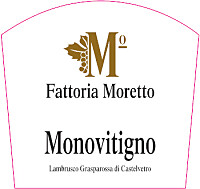
|
|
Lambrusco Grasparossa di Castelvetro Monovitigno 2019 |
|
| Fattoria Moretto (Emilia-Romagna, Italy) | |
 Lambrusco Grasparossa Lambrusco Grasparossa | |
| Price: € 12.00 | Score: |
 Deep ruby red and nuances of purple red, little transparency, fine and
persistent perlage. Deep ruby red and nuances of purple red, little transparency, fine and
persistent perlage.
 Intense, clean, pleasing and refined, starts with hints of black
cherry, strawberry and raspberry followed by aromas of rose, violet, peony,
cyclamen, plum, blueberry and pomegranate. Intense, clean, pleasing and refined, starts with hints of black
cherry, strawberry and raspberry followed by aromas of rose, violet, peony,
cyclamen, plum, blueberry and pomegranate.
 Effervescent and properly tannic attack, however balanced by alcohol,
good body, intense flavors, pleasing crispness. Effervescent and properly tannic attack, however balanced by alcohol,
good body, intense flavors, pleasing crispness.
 Persistent finish with flavors of black cherry, strawberry and
raspberry. Persistent finish with flavors of black cherry, strawberry and
raspberry.
 Produced with long Charmat method. Produced with long Charmat method. |
|
 Cold cuts, Pasta with meats, Sauteed meat, Stewed meat with mushrooms Cold cuts, Pasta with meats, Sauteed meat, Stewed meat with mushrooms |
|
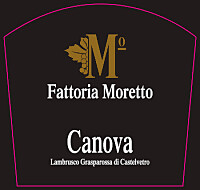
|
|
Lambrusco Grasparossa di Castelvetro Canova 2019 |
|
| Fattoria Moretto (Emilia-Romagna, Italy) | |
 Lambrusco Grasparossa Lambrusco Grasparossa | |
| Price: € 12.00 | Score: |
 Deep ruby red and nuances of purple red, little transparency, fine and
persistent perlage. Deep ruby red and nuances of purple red, little transparency, fine and
persistent perlage.
 Intense, clean, pleasing and refined, starts with hints of black
cherry, blackberry and raspberry followed by aromas of gernaium, violet,
strawberry, cyclamen, pomegranate, blueberry and plum. Intense, clean, pleasing and refined, starts with hints of black
cherry, blackberry and raspberry followed by aromas of gernaium, violet,
strawberry, cyclamen, pomegranate, blueberry and plum.
 Effervescent and properly tannic attack, however balanced by alcohol,
good body, intense flavors, pleasing crispness. Effervescent and properly tannic attack, however balanced by alcohol,
good body, intense flavors, pleasing crispness.
 Persistent finish with flavors of black cherry, blackberry and
raspberry. Persistent finish with flavors of black cherry, blackberry and
raspberry.
 Produced with long Charmat method. Produced with long Charmat method. |
|
 Cold cuts, Pasta with meat, Stewed meat with mushrooms Cold cuts, Pasta with meat, Stewed meat with mushrooms |
|
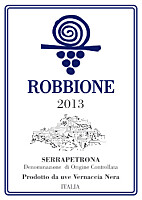
|
|
Serrapetrona Robbione 2013 |
|
| Terre di Serrapetrona (Marches, Italy) | |
 Vernaccia Nera Vernaccia Nera | |
| Price: € 24.50 | Score: |
 Intense ruby red and nuances of garnet red, little transparency. Intense ruby red and nuances of garnet red, little transparency. Intense, clean, pleasing, refined and elegant, starts with hints of
black cherry, plum and black pepper followed by aromas of dried violet,
strawberry, blueberry, graphite, chocolate, tobacco, licorice, rosemary,
vanilla and menthol. Intense, clean, pleasing, refined and elegant, starts with hints of
black cherry, plum and black pepper followed by aromas of dried violet,
strawberry, blueberry, graphite, chocolate, tobacco, licorice, rosemary,
vanilla and menthol.
 Properly tannic attack and however balanced by alcohol, good body,
intense flavors, agreeable. Properly tannic attack and however balanced by alcohol, good body,
intense flavors, agreeable.
 Persistent finish with flavors of black cherry, plum and strawberry. Persistent finish with flavors of black cherry, plum and strawberry. 24 months in steel tanks, 24 months in cask, 12 months in bottle. 24 months in steel tanks, 24 months in cask, 12 months in bottle. |
|
 Broiled meat and barbecue, Stewed meat with mushrooms, Roasted meat Broiled meat and barbecue, Stewed meat with mushrooms, Roasted meat |
|
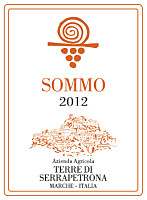
|
|
Sommo 2012 |
|
| Terre di Serrapetrona (Marches, Italy) | |
 Vernaccia Nera Vernaccia Nera | |
| Price: € 19.00 - 500ml | Score: |
 Intense ruby red and nuances of garnet red, little transparency. Intense ruby red and nuances of garnet red, little transparency. Intense, clean, pleasing, refined and elegant, starts with hints of
black cherry, blackberry and strawberry followed by aromas of dried violet,
dried rose, plum, blueberry, cinnamon, cocoa, tobacco, leather, tamarind,
rhubarb, vanilla and graphite. Intense, clean, pleasing, refined and elegant, starts with hints of
black cherry, blackberry and strawberry followed by aromas of dried violet,
dried rose, plum, blueberry, cinnamon, cocoa, tobacco, leather, tamarind,
rhubarb, vanilla and graphite.
 Sweet and round attack, however balanced by alcohol, good body, intense
flavors, pleasing crispness and astringency. Sweet and round attack, however balanced by alcohol, good body, intense
flavors, pleasing crispness and astringency.
 Persistent finish with flavors of black cherry, blackberry and
strawberry. Persistent finish with flavors of black cherry, blackberry and
strawberry.
 24 months in steel tanks, 24 months in cask, 6 months in bottle. 24 months in steel tanks, 24 months in cask, 6 months in bottle. |
|
 Fruit tarts, Confectionery, Hard cheese Fruit tarts, Confectionery, Hard cheese |
|
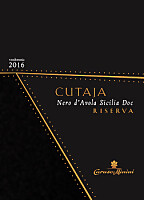
|
|
Sicilia Nero d'Avola Riserva Cutaja 2016 |
|
| Caruso & Minini (Sicily, Italy) | |
 Nero d'Avola Nero d'Avola | |
| Price: € 18.00 | Score: |
 Brilliant ruby red and nuances of ruby red, little transparency. Brilliant ruby red and nuances of ruby red, little transparency. Intense, clean, pleasing, refined and elegant, starts with hints of
plum, blackberry and dried violet followed by aromas of black cherry,
blueberry, tobacco, carob, cocoa, cinnamon, mace, vanilla and menthol. Intense, clean, pleasing, refined and elegant, starts with hints of
plum, blackberry and dried violet followed by aromas of black cherry,
blueberry, tobacco, carob, cocoa, cinnamon, mace, vanilla and menthol.
 Properly tannic attack and however balanced by alcohol, good body,
intense flavors, pleasing roundness. Properly tannic attack and however balanced by alcohol, good body,
intense flavors, pleasing roundness.
 Persistent finish with flavors of plum, blackberry and black cherry. Persistent finish with flavors of plum, blackberry and black cherry. 18 months in cask, 6 months in bottle. 18 months in cask, 6 months in bottle. |
|
 Stuffed pasta, Broiled meat and barbecue, Roasted meat, Stewed meat, Cheese Stuffed pasta, Broiled meat and barbecue, Roasted meat, Stewed meat, Cheese |
|
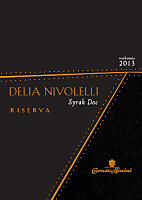
|
|
Delia Nivolelli Syrah Riserva 2013 |
|
| Caruso & Minini (Sicily, Italy) | |
 Syrah Syrah | |
| Price: € 26.00 | Score: |
 Intense ruby red and nuances of garnet red, little transparency. Intense ruby red and nuances of garnet red, little transparency. Intense, clean, pleasing, refined and elegant, starts with hints of
plum, black cherry and black currant followed by aromas of dried violet,
blueberry, peony, chocolate, tobacco, cinnamon, leather, licorice, mace,
vanilla and menthol. Intense, clean, pleasing, refined and elegant, starts with hints of
plum, black cherry and black currant followed by aromas of dried violet,
blueberry, peony, chocolate, tobacco, cinnamon, leather, licorice, mace,
vanilla and menthol.
 Properly tannic attack and however balanced by alcohol, good body,
intense flavors, pleasing roundness. Properly tannic attack and however balanced by alcohol, good body,
intense flavors, pleasing roundness.
 Persistent finish with flavors of plum, black cherry and black currant. Persistent finish with flavors of plum, black cherry and black currant. 24 months in cask, 6 months in bottle. 24 months in cask, 6 months in bottle. |
|
 Roasted meat, Stewed meat with mushrooms, Hard cheese Roasted meat, Stewed meat with mushrooms, Hard cheese |
|
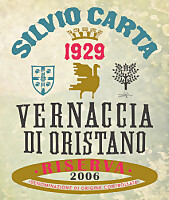
|
|
Vernaccia di Oristano Riserva 2006 |
|
| Silvio Carta (Sardinia, Italy) | |
 Vernaccia di Oristano Vernaccia di Oristano | |
| Price: € 60.00 | Score: |
 Brilliant amber yellow and nuances of amber yellow, transparent. Brilliant amber yellow and nuances of amber yellow, transparent. Intense, clean, pleasing, refined and elegant, starts with hints of
dried fig, rancho and honey followed by aromas of leather, caramel, almond,
date, coffee, walnut husk, citrus fruit peel, praline, tobacco, oregano,
vanilla and nail polish. Intense, clean, pleasing, refined and elegant, starts with hints of
dried fig, rancho and honey followed by aromas of leather, caramel, almond,
date, coffee, walnut husk, citrus fruit peel, praline, tobacco, oregano,
vanilla and nail polish.
 Crisp and round attack, however balanced by alcohol, intense flavors,
full body, agreeable. Crisp and round attack, however balanced by alcohol, intense flavors,
full body, agreeable.
 Very persistent finish with very long flavors of dried fig, date and
almond. Very persistent finish with very long flavors of dried fig, date and
almond.
 Aged in small barrels. Aged in small barrels. |
|
 Jam tarts Jam tarts |
|
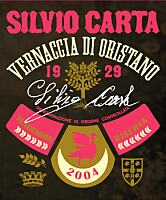
|
|
Vernaccia di Oristano Riserva 2004 |
|
| Silvio Carta (Sardinia, Italy) | |
 Vernaccia di Oristano Vernaccia di Oristano | |
| Price: € 60.00 | Score: |
 Deep amber yellow and nuances of amber yellow, transparent. Deep amber yellow and nuances of amber yellow, transparent. Intense, clean, pleasing, refined and elegant, starts with hints of
dried fig, leather and rancho followed by aromas of citrus fruit peel,
almond, date, caramel, tobacco, coffee, licorice, walnut husk, honey,
hazelnut, oregano, praline, vanilla and nail polish. Intense, clean, pleasing, refined and elegant, starts with hints of
dried fig, leather and rancho followed by aromas of citrus fruit peel,
almond, date, caramel, tobacco, coffee, licorice, walnut husk, honey,
hazelnut, oregano, praline, vanilla and nail polish.
 Crisp and round attack, however balanced by alcohol, full body, intense
flavors, agreeable. Crisp and round attack, however balanced by alcohol, full body, intense
flavors, agreeable.
 Very persistent finish with very long flavors of dried fig, honey,
praline and almond. Very persistent finish with very long flavors of dried fig, honey,
praline and almond.
 Aged in small barrels. Aged in small barrels. |
|
 Jam tarts Jam tarts |
|
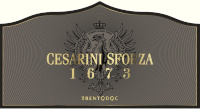
|
|
Trento Riserva Extra Brut 1673 2012 |
|
| Cesarini Sforza (Trentino, Italy) | |
 Chardonnay Chardonnay | |
| Price: € 30.00 | Score: |
 Brilliant straw yellow and nuances of straw yellow, very transparent,
fine and persistent perlage. Brilliant straw yellow and nuances of straw yellow, very transparent,
fine and persistent perlage.
 Intense, clean, pleasing, refined and elegant, starts with hints of
banana, acacia and bread crust followed by aromas of apple, grapefruit,
plum, pear, hawthorn, beeswax, hazelnut, croissant and mineral. Intense, clean, pleasing, refined and elegant, starts with hints of
banana, acacia and bread crust followed by aromas of apple, grapefruit,
plum, pear, hawthorn, beeswax, hazelnut, croissant and mineral.
 Crisp and effervescent attack, however balanced by alcohol, good body,
intense flavors, agreeable. Crisp and effervescent attack, however balanced by alcohol, good body,
intense flavors, agreeable.
 Persistent finish with flavors of banana, grapefruit and hazelnut. Persistent finish with flavors of banana, grapefruit and hazelnut. The base wine ages for 6 months in steel tanks. Refermented in bottle
on its lees for at least 60 months. The base wine ages for 6 months in steel tanks. Refermented in bottle
on its lees for at least 60 months.
|
|
 Stuffed pasta with mushrooms, Roasted white meat, Roasted fish, Mushroom soups Stuffed pasta with mushrooms, Roasted white meat, Roasted fish, Mushroom soups |
|
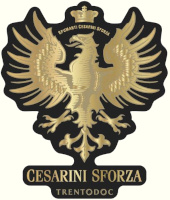
|
|
Trento Riserva Brut Aquila Reale 2010 |
|
| Cesarini Sforza (Trentino, Italy) | |
 Chardonnay Chardonnay | |
| Price: € 45.00 | Score: |
 Brilliant straw yellow and nuances of golden yellow, very transparent,
fine and persistent perlage. Brilliant straw yellow and nuances of golden yellow, very transparent,
fine and persistent perlage.
 Intense, clean, pleasing, refined and elegant, starts with hints of
banana, plum and bread crust followed by aromas of acacia, apple,
grapefruit, pear, hawthorn, croissant, candied fruit, butter, praline and
honey. Intense, clean, pleasing, refined and elegant, starts with hints of
banana, plum and bread crust followed by aromas of acacia, apple,
grapefruit, pear, hawthorn, croissant, candied fruit, butter, praline and
honey.
 Crisp an effervescent attack, however balanced by alcohol, good body,
intense flavors, pleasing roundness. Crisp an effervescent attack, however balanced by alcohol, good body,
intense flavors, pleasing roundness.
 Very persistent finish with long flavors of banana, plum and
grapefruit. Very persistent finish with long flavors of banana, plum and
grapefruit.
 The base wine ages in cask. Refermented in bottle on its lees for 90
months. The base wine ages in cask. Refermented in bottle on its lees for 90
months.
|
|
 Stuffed pasta with mushrooms, Roasted fish, Stewed fish with mushrooms, Roasted white meat Stuffed pasta with mushrooms, Roasted fish, Stewed fish with mushrooms, Roasted white meat |
|
|
||||||||
|
DiWineTaste Polls
|
| |||||||
Privacy Policy | |||||||


| Copyright © 2002-2024 Antonello Biancalana, DiWineTaste - All rights reserved |
| All rights reserved under international copyright conventions. No part of this publication and of this WEB site may be
reproduced or utilized in any form or by any means, electronic or mechanical, without permission in writing from DiWineTaste. |